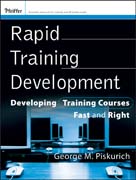
Rapid training development: developing training courses fast and right
Piskurich, George M.
Provides no-nonsense, highly efficient techniques for one aspect of the for avariety of typical training processes, including classroom and on-the-job training and mentoring, and shows how to use these techniques in a variety of delivery systems, including computer-based and mobile learning. It also addressesother development techniques that can augment the rapid course development methods in the book. Begins by explaining what is (and isnt) Course Development,provides general rapid course development techniques as well as for classroomcourse development. This last chapter sets the model for the rest of the book, providing first a brief synopsis of the important aspects of developing classroom based courses, followed by a discussion of the various end products of the process, illuminated by examples. This is followed by a section on proven general techniques for rapid development that includes at least one case example of each technique. The next section addresses specific rapid development techniques for each of the end products where applicable, and includes illustrations of the techniques in use. The next several chapters follow the model described above, but for each of the other major delivery processes, including OJT,asynchronous and synchronous, and structured mentoring. The last few chaptersexplore the use of various techniques for rapid course development, includingself-directed learning, performance tools, and more modern delivery system techniques, including computer-based training, and the new mobile technologies such as podcasting and PDA-based learning. The chapter ends with a matrix of all the techniques in a chart format that indicates where they work best.
- ISBN: 978-0-470-39977-4
- Editorial: John Wiley & Sons
- Encuadernacion: Rústica
- Páginas: 192
- Fecha Publicación: 03/06/2009
- Nº Volúmenes: 1
- Idioma: Inglés
